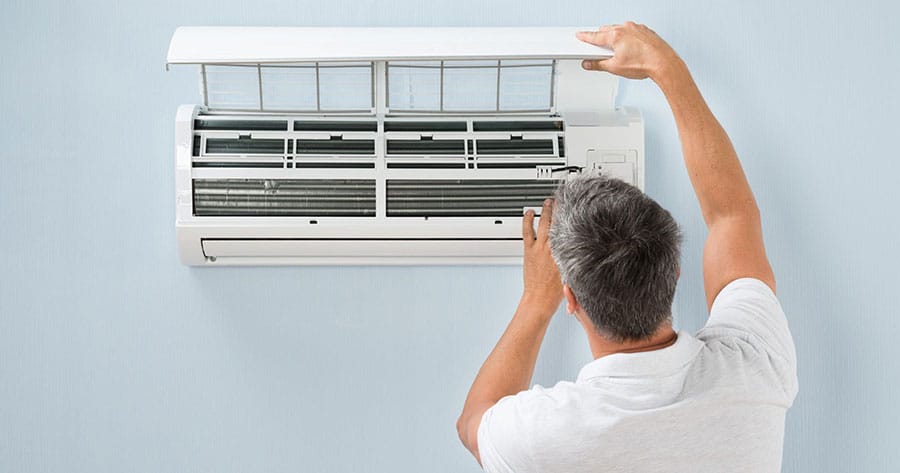We've independently reviewed this article to make sure it's as accurate as we can make it.
To find out more about our article creation and review process, check out our editorial guidelines.
Ductless mini-split systems are a fantastic addition to any home. They give us the benefit of whole-house AC systems, complete with multi-zone control, all without much noise or hassle.
How long does it take to install a mini-split system?
Installing a Ductless Mini Split system takes a contractor a few hours. This can extend up to 1-2 days for complex, multi-room systems. Installing the system consists of drilling the ductless access hole, feeding through wires, installing the brackets, then attaching the mini split unit itself.
How Long Does a Standard Installation Take?
Installing a ductless mini-split system doesn’t take longer than any other type of system. It’s much quicker than anything involving central AC’s which need large ducts installed and maintained.
That said, you do want a qualified contractor to do the job for you. These are permanent installations, so you want them to be done right!
It’s not quite as fast to install than a quiet window air conditioner, but there’s good reason for that. A mini split is a much more efficient, permanent system than even the best window ac.
The actual installation work is relatively simple. You need to drill the access hole (around 3”), run the electrical power to the location of the outdoor unit, install the indoor and outdoor brackets, then mount the units.
You can expect a good contractor to have this done for one unit within a few hours.
Of course, multiple units will take a lot more time – simply multiply things up. Allowing a half-day for each unit is a good rule of thumb.
What About Complications?
Like with any major appliance, complications can arise.
While these can’t always be prevented, they can be prepared for. Have a think through this following list, and try to predict whether any of these might be an issue. If they are, it’s best to pre-warn your contractor (and maybe expect some extra installation time):
- Complex electrics. With an old home, or one with a complicated layout, running the right electricity and breakers to connect the system may be a challenge.
- Complex logistics. Trying to squeeze the unit into a corner, or needing to redirect the cables on the exterior may take some extra time.
- Large areas. A multi-unit install over a large home can take some time. Not just to get around the home, but to do repeated tests and checks on all systems.
- Previous ductwork. If you have old ducts, you may not need to remove them but it’s a good idea to seal these off and prevent build up of dust/mold (or worse, living things!)
- Upper floors. For units above the ground floor – particularly in apartments – these are a level of complexity above the installation that can be done with two feet on the ground. For ease of installation, the water ideal situation is the outdoor unit directly on the wall opposite the indoor unit.
If you’re getting a multi-zone system, this can take a little longer to set up and test. (And believe me, it’s always worth testing things fully while you have the contractor there).
How Much Will Installation Cost?
The cost of installing a mini split system depends on a lot of factors. Generally, a basic installation can be anywhere between $1,000 to $3,000 for labour, depending on any logistics issues and the number of units you need installing.
Another factor is whether you’re using a single or multi-zone system. The latter being more complex to set up (and longer to test).
Installation costs can also extend to other parts of the system, too. If you’re installing the exterior unit onto the ground, you’ll probably want a concrete pad installed to hold and protect it. This can cost around $75-$150 per pad.
Further, you may need new electric circuits to accommodate the air conditioners. Professionally these can cost between $400-$1,000 to get installed by a licensed electrician.
Do I Need A Licence Or Permit To Install A Mini Split AC?
This does depend on your state, but more likely than not you’ll need both a permit and license to install a mini-split. Most states do allow a homeowner to do work on their own home, but you still need a permit and inspection.
Are Mini Split Air Conditioners Worth It?
Mini split air conditioners look great, but are they worth the cost?
Of course this depends on who you ask! For myself, and most other mini-split owners, these ductless systems are absolutely worth it. Some of my favorite benefits are:
- Clean, cool, easy airflow. These systems work extremely well, and are very quiet.
- No complicated ducts that can cause problems and always need maintained. No more worrying about mold or rodents within the ducts!
- Multi-zone control can keep everyone happy. No more fighting over the thermostat.
To be honest, the most daunting part of these systems is that they can be unfamiliar. Although the system is the same (using the same evaporator, condenser, etc) – they can feel very different to a normal system. And it’s hard to trust something we find weird.
That being said, these systems are skyrocketing in their popularity. And for good reason. They take up minimal space, are quiet, work great, and need very little maintenance. Especially compared to central air conditioning systems.
They also tend to cost less to run than a traditional central air conditioning system. They’re normally variable speed and, since they don’t have ducts, they don’t need a powerful blower to push the air through the ducts.
Mini Split Systems Compared to Central AC
If you’re considering a mini-split system, you might be mentally comparing it to a traditional central air conditioning system. And for good reason – they both have their benefits.
To help, I’ve put together this quick pros and cons table to compare the two. Sometimes looking at things from a top-down view is the best way to realize what would suit you better.
| Mini-Split Air Conditioners | |
|---|---|
| Pros | Cons |
Can control cooling per room | Doesn’t bring in fresh air |
Better/cheaper if retrofitting without ductwork | More expensive than ducted systems (if you have ductwork) |
Easier to install. Doesn’t weigh much. | Visible inside the home. |
Multiple options – wall mounted, ceiling recessed, etc. | May need multiple to cover whole home. |
Often comes with heater element for winter. | |
20-30% more efficient than central AC. | |
Quieter than central AC. | |
| Central Air Conditioners | |
|---|---|
| Pros | Cons |
Can add value to a home | Needs regular maintenance |
Can be cheaper up-front cost | Less efficient; higher energy bills |
Zone control possible | Zone control needs high-end parts |
Brings in fresh air | Ducts can build-up pollen, mold, dust, etc. |
Hidden from view | Central unit is noisier than ductless. |
Installation can be complex/lengthy. |
|
For more, check out our full post comparing mini split vs central air conditioning systems.
Conclusion
Mini-split systems are still fresh and are getting installed in households across the country.
However, these new systems leave a lot of questions. A main one being how long they take to install.
I hope this quick guide has helped boost your confidence about getting one of these newer systems. I personally love them, and can’t see myself ever dealing with the hassle of a central air system again.
If this article has helped you, please consider checking out some of our related articles below! We’re entirely reader supported, and every minute you spend reading our content really helps us out.
Thanks for reading. And have a great day!
-Craig







